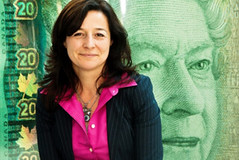
PREV ARTICLE
NEXT ARTICLE
FULL ISSUE
PREV FULL ISSUE
THE SCIENTIST OF THE BANK OF CANADA
This article from The Ottawa Citizen profiles the Bank of Canada's banknote scientific adviser.
-Editor
Ironically, now that she's actually held the position — her official title is banknote scientific adviser — for the past half dozen years, she has to be circumspect about revealing the details of what she does. That's because it's her job to make counterfeiters' jobs more difficult; a cat-and-mouse game where by inventing and implementing security features on Canadian paper currency, the gap between real and fake is made as wide as possible, so that the people and machines that handle money can easily recognize the bogus bills. "Our job is to work to stay ahead of counterfeiting and counterfeiters," she says, "and that involves chemistry, physics, biology and psychology, in different ways. "We look to see what the counterfeiters do, what they have available, what they could have available, what we think they will make use of and how they would make use of it. If the counterfeits are getting close to the banknotes, then we start looking at solutions, at what we can buy to put on the banknotes to make them more secure." And when one technology no longer deters counterfeiters, it's Firth's job to come up with something that will. With holograms becoming increasingly common, for example, some analysts are now touting nanoholes — tiny holes which in butterfly wings block out certain wavelengths of light and produce their familiar iridescence — as the next anti-counterfeiting measure. Mum's the word, though, on what new technologies will be used in Canada's new paper currency, which is officially being announced Monday and will roll off the presses with the $100-bill in the fall. The only information available so far about the new series is that it will be printed on a plastic polymer, as opposed to the cotton-based currency now in circulation. The polymer, while more difficult to counterfeit, will also more than double the life expectancy of bills. Each of the 840 million $20-bills — the most popular denomination — now in circulation are expected to last three years. The polymer $20s will last seven and a half. "A security feature that's going out into circulation in November 2011 came from me, came from a concept in my mind," she adds. "What we've worked on, every Canadian is going to touch. That's pretty cool. "If a security feature that started out on my drafting board ends up on a banknote, I'll be doing a happy dance and drinking champagne."
To read the complete article, see:
The Bank Scientist
(www.ottawacitizen.com/news/Bank+Scientist/4958428/story.html)
The Numismatic Bibliomania Society is a non-profit organization promoting numismatic literature. See our web site at coinbooks.org. To submit items for publication in The E-Sylum, write to the Editor at this address: whomren@gmail.com To subscribe go to: https://my.binhost.com/lists/listinfo/esylum All Rights Reserved. NBS Home Page Contact the NBS webmaster 
|
